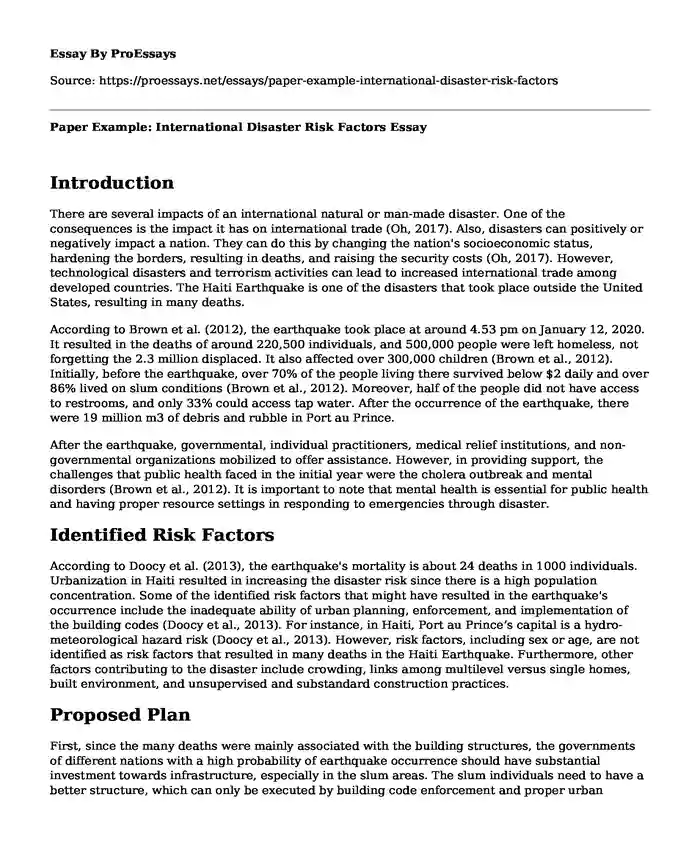Introduction
There are several impacts of an international natural or man-made disaster. One of the consequences is the impact it has on international trade (Oh, 2017). Also, disasters can positively or negatively impact a nation. They can do this by changing the nation's socioeconomic status, hardening the borders, resulting in deaths, and raising the security costs (Oh, 2017). However, technological disasters and terrorism activities can lead to increased international trade among developed countries. The Haiti Earthquake is one of the disasters that took place outside the United States, resulting in many deaths.
According to Brown et al. (2012), the earthquake took place at around 4.53 pm on January 12, 2020. It resulted in the deaths of around 220,500 individuals, and 500,000 people were left homeless, not forgetting the 2.3 million displaced. It also affected over 300,000 children (Brown et al., 2012). Initially, before the earthquake, over 70% of the people living there survived below $2 daily and over 86% lived on slum conditions (Brown et al., 2012). Moreover, half of the people did not have access to restrooms, and only 33% could access tap water. After the occurrence of the earthquake, there were 19 million m3 of debris and rubble in Port au Prince.
After the earthquake, governmental, individual practitioners, medical relief institutions, and non-governmental organizations mobilized to offer assistance. However, in providing support, the challenges that public health faced in the initial year were the cholera outbreak and mental disorders (Brown et al., 2012). It is important to note that mental health is essential for public health and having proper resource settings in responding to emergencies through disaster.
Identified Risk Factors
According to Doocy et al. (2013), the earthquake's mortality is about 24 deaths in 1000 individuals. Urbanization in Haiti resulted in increasing the disaster risk since there is a high population concentration. Some of the identified risk factors that might have resulted in the earthquake's occurrence include the inadequate ability of urban planning, enforcement, and implementation of the building codes (Doocy et al., 2013). For instance, in Haiti, Port au Prince’s capital is a hydro-meteorological hazard risk (Doocy et al., 2013). However, risk factors, including sex or age, are not identified as risk factors that resulted in many deaths in the Haiti Earthquake. Furthermore, other factors contributing to the disaster include crowding, links among multilevel versus single homes, built environment, and unsupervised and substandard construction practices.
Proposed Plan
First, since the many deaths were mainly associated with the building structures, the governments of different nations with a high probability of earthquake occurrence should have substantial investment towards infrastructure, especially in the slum areas. The slum individuals need to have a better structure, which can only be executed by building code enforcement and proper urban planning. Therefore, the best plan is to rebuild structures in the crowded slum with improved earthquake-proof construction. The strategy is significant for the future preparedness of a disaster like an earthquake in those areas. The reason is that it helps in absorbing seismic waves and preventing them from traveling. Another good plan is making the community ready for the disaster and teaching them the best ways of being prepared to avoid many deaths. Information that can be shared includes hazard hunts, retrofitting programs, and family and neighborhood emergency plans such as dropping on the ground.
References
Brown, C., Ripp, J., & Kazura, J. (2012). Perspectives on Haiti two years after the earthquake. The American journal of tropical medicine and hygiene, 86(1), 5. https://www.ncbi.nlm.nih.gov/pmc/articles/PMC3247098/
Doocy, S., Cherewick, M., & Kirsch, T. (2013). Mortality following the Haitian earthquake of 2010: a stratified cluster survey. Population health metrics, 11(1), 5. https://doi.org/10.1186/1478-7954-11-5
Oh, C. H. (2017). How do natural and man-made disasters affect international trade? A country-level and industry-level analysis. Journal of Risk Research, 20(2), 195-217. https://doi.org/10.1080/13669877.2015.1042496
Cite this page
Paper Example: International Disaster Risk Factors. (2023, Dec 13). Retrieved from https://proessays.net/essays/paper-example-international-disaster-risk-factors
If you are the original author of this essay and no longer wish to have it published on the ProEssays website, please click below to request its removal:
- Paper Example on Poverty and Effects On Child and Family
- The Aspect of Euthanasia in the Perspective Utilitarian and Kantian Analysis Essay
- Nurse Leadership Styles in Promoting Electronic Medication System
- Antibiotic Development Essay Example
- Diagnosing Disease: Internal & External Cues - Essay Sample
- Essay Example on California vs Hawaii: Comparing NPs' Laws & Requirements
- Essay Sample on Ultrasound: A Nurse's Tool to Identify Pressure Injuries







